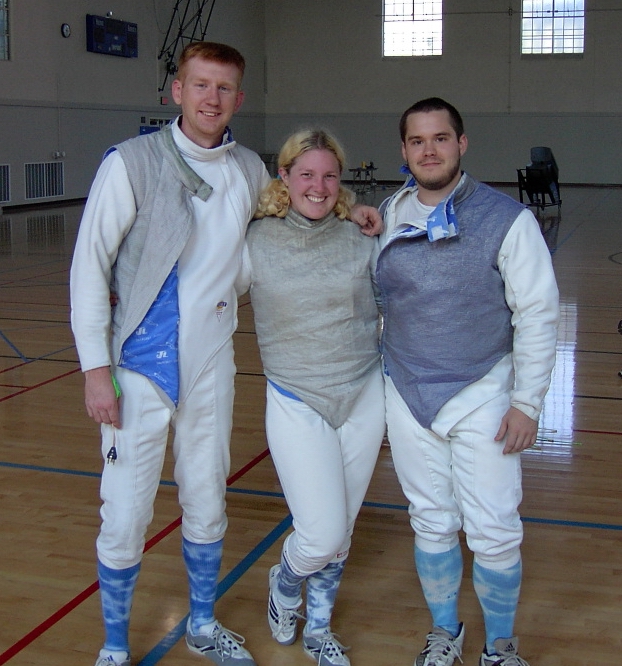If you want to see a sport that combines the element of fast-paced action with the element of people screaming in French, you should check out Olympic fencing…Actually, there are three Olympic fencing events: the “ipie,” the “saber,” and “the third type of Olympic fencing event.” The object in all three is to touch your opponent with your weapon; the winner is the first fencer who, within the allotted time, swings across the room on the chandelier…No, seriously, they score by touching the opponent in the Valid Target Area. The touches are monitored electronically via wires coming out of the fencers’ backs, similar to the technology used to control Dan Rather. The fencers also wear face masks, so that they’ll have something to whip off in a dramatic fashion when they want to complain to the referee. Dave Barry, Atlanta, 1996
Geography grad student Tom Pingel (in the blue shirt at left) recently got off the fence and explained a few of the finer points of fencing that Dave Barry touched on:
I started fencing during my first year at Iowa State University. Some friends of mine and I saw the flyers (something about pirates as I recall), and decided to give it a go. It turned out to be a lot of fun, and I’ve stuck with it ever since! I started fencing foil (the other two weapons are epee and saber). Foil is a much lighter version of the dueling sword, and is used mainly to teach the give and take of swordplay. When I came to UCSB, I started fencing on the collegiate team and helped win our team 3rd place in the southern California collegiate fencing league. I was foil team captain from 2002-2004, and led our team to strong finishes in what was a very tough league. I was fencing team president the year after that, and now I coach the team.
We recently got Tim Robinson (who also interacts with our department a good deal through the IGERT program) as head coach, and I mainly coach the epee team. A few years ago, I started fencing epee and it has really become my favorite weapon to fence. Unlike foil, the rules of epee are quite simple – one must “touch” one’s opponent before he or she scores a touch on you. This is intended to approximate dueling to first blood. Epee used to be fenced to a single touch (to keep with the dueling tradition of drawing first blood), though now we fence to 5 or 15 touches.
This year I met two fencing goals – I won my “C” rating in both epee and foil. I won the southern California division qualifier for summer nationals (in epee) in February, and just recently won a competition in San Luis Obispo (in foil). The rating system is a little difficult to explain, but a “C” rating is a very strong regional rating. I qualified for the right to compete at the national Division II level at the championships next month in Miami. I also led the men’s epee team at the All California Club Championships this year to a second place finish, and helped win UCSB 2nd place overall at the tournament.
I think fencing attracts me because of the speed, timing, and strategy required to succeed. It’s a mental game that requires perfect physical execution. It’s also something that you can do for a lifetime. As you get older, better technique and strategy take the place of the raw speed and power that you have when you’re younger. Fencing is also exciting because it’s very individual – you face a single opponent at a time, and your success and failure depend only on how well you perform.




